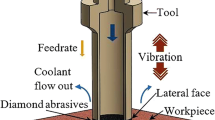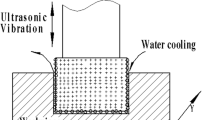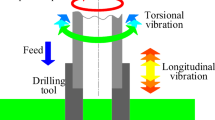Abstract
Modelling the thrust force of rotary ultrasonic drilling (RUD) is an important aspect for optimizing the process parameters and predicting the material cracking and edge chipping. Mainly, the material removal of brittle material occurs mainly through the brittle mode, while the ductile mode occurs in case of micro or nano-depth of cut. This paper introduces a mathematical model for thrust force based on the two material removal modes. The mathematical model correlates the thrust force with the material characteristics and the machining parameters as feed rate, spindle speed, ultrasonic amplitude, frequency and tool abrasive size, tip angle, and concentration. Complete hole drilling and scratch-drilling with depth of 10-μm experiments are conducted in soda glass to verify the model. Thrust force measurement and microstructure features are used to verify the model. The predicted model results agree with the experimental results. The model predicts that the range of feed rate and spindle speed produce the ductile mode cutting.
Similar content being viewed by others
References
Wang J, Feng P, Zhang J (2018) Reducing edge chipping defect in rotary ultrasonic machining of optical glass by compound step-taper tool. J Manuf Process 32:213–221. https://doi.org/10.1016/j.jmapro.2018.02.001
Abdelkawy A, Hossam M, El-hofy H (2018) Machinability assessment of soda lime glass in ultrasonic-assisted drilling. Solid State Phenom 278:23–27. https://doi.org/10.4028/www.scientific.net/SSP.278.23
Wang JJ, Feng P, Zheng J, Zhang J (2016) Improving hole exit quality in rotary ultrasonic machining of ceramic matrix composites using a compound step-taper drill. Ceram Int 42:13387–13394. https://doi.org/10.1016/j.ceramint.2016.05.095
Zhang C, Cong W, Feng P, Pei Z (2013) Rotary ultrasonic machining of optical K9 glass using compressed air as coolant: a feasibility study. Proc Inst Mech Eng Part B J Eng Manuf 228:504–514. https://doi.org/10.1177/0954405413506195
Ning FD, Cong WL, Pei ZJ, Treadwell C (2016) Rotary ultrasonic machining of CFRP: a comparison with grinding. Ultrasonics 66:125–132. https://doi.org/10.1016/j.ultras.2015.11.002
Ding K, Fu Y, Su H, Chen Y, Yu X, Ding G (2014) Experimental studies on drilling tool load and machining quality of C/SiC composites in rotary ultrasonic machining. J Mater Process Technol 214:2900–2907. https://doi.org/10.1016/j.jmatprotec.2014.06.015
Makhdum F, Phadnis VA, Roy A, Silberschmidt VV (2014) Effect of ultrasonically-assisted drilling on carbon-fibre-reinforced plastics. J Sound Vib 333:5939–5952. https://doi.org/10.1016/j.jsv.2014.05.042
Cong WL, Pei ZJ, Sun X, Zhang CL (2014) Rotary ultrasonic machining of CFRP: a mechanistic predictive model for cutting force. Ultrasonics 54:663–675. https://doi.org/10.1016/j.ultras.2013.09.005
Baraheni M, Amini S (2018) Feasibility study of delamination in rotary ultrasonic-assisted drilling of glass fiber reinforced plastics. J Rein Plast Comp 37:3–12. https://doi.org/10.1177/0731684417729565
Sun L, Yang S, Yang L, Zhao P, Wu P, Jiang Z (2015) A new model of grinding forces prediction for machining brittle and hard materials. Procedia CIRP 27:192–197. https://doi.org/10.1016/j.procir.2015.04.065
Pei ZJ, Prabhakar D, Ferreira PM, Haselkorn MA (1995) Mechanistic approach to the prediction of material removal rates in rotary ultrasonic machining. J Eng Ind 117:142. https://doi.org/10.1115/1.2803288
Zhang QH, Wu CL, Sun JL, Jia ZX (2000) The mechanism of material removal in ultrasonic drilling of engineering ceramics. Proc Inst Mech Eng Part B J Eng Manuf 214:805–810. https://doi.org/10.1243/0954405001517874
Liu D, Cong WL, Pei ZJ, Tang Y (2012) A cutting force model for rotary ultrasonic machining of brittle materials. Int J Mach Tools Manuf 52:77–84. https://doi.org/10.1016/j.ijmachtools.2011.09.006
Bifano TG, Dow TA, Scattergood RO (1991) Ductile-regime grinding: a new technology for machining brittle materials. J Eng Ind 113:184. https://doi.org/10.1115/1.2899676
Yoshino M, Sivanandam A, Kinouchi Y, Matsumura T (2006) Critical depth of hard-brittle materials on nano plastic forming. Trans Japan Soc Mech Eng Ser C 72:3412–3418. https://doi.org/10.1299/kikaic.72.3412
Zhang X, Arif M, Liu K, Kumar AS, Rahman M (2013) A model to predict the critical undeformed chip thickness in vibration-assisted machining of brittle materials. Int J Mach Tools Manuf 69:57–66. https://doi.org/10.1016/j.ijmachtools.2013.03.006
Zhou M, Zhao P (2016) Prediction of critical cutting depth for ductile-brittle transition in ultrasonic vibration assisted grinding of optical glasses. Int J Adv Manuf Technol 86:1775–1784. https://doi.org/10.1007/s00170-015-8274-9
Cao J, Nie M, Liu Y, Li J (2018) Ductile-brittle transition behavior in the ultrasonic vibration-assisted internal grinding of silicon carbide ceramics. Int J Adv Manuf Technol 96:3251–3262. https://doi.org/10.1007/s00170-018-1715-5
Qin N, Pei ZJ, Treadwell C, Guo DM (2009) Physics-based predictive cutting force model in ultrasonic-vibration-assisted grinding for titanium drilling. J Manuf Sci Eng 131:41011. https://doi.org/10.1115/1.3159050
Atkinson C, Martinez-Esnaola JM, Elizalde MR (2012) Contact mechanics: a review and some applications. Mater Sci Technol 28:1079–1091. https://doi.org/10.1179/1743284711Y.000000012.
Wang JJ (2007) Critical depth of cut and specific cutting energy of a microscribing process for hard and brittle. J Eng Mater Technol 130:1–6. https://doi.org/10.1115/1.2806253.
Lv D, Zhang Y, Peng Y (2016) High-frequency vibration effects on hole entrance chipping in rotary ultrasonic drilling of BK7 glass. Ultrasonics 72:47–56. https://doi.org/10.1016/j.ultras.2016.07.011
Wu J, Cong W, Williams RE, Pei ZJ (2011) Dynamic process modeling for rotary ultrasonic machining of alumina. J Manuf Sci Eng 133:41012. https://doi.org/10.1115/1.4004688
Cong W, Feng Q, Pei Z, Deines T, Treadwell C (2012) Rotary ultrasonic machining of carbon fiber-reinforced plastic composites: using cutting fluid vs. cold air as coolant. J Compos Mater 46:1745–1753. https://doi.org/10.1177/0021998311424625
Acknowledgments
This research work is sponsored by the Egyptian Ministry of Higher Education (MoHE) grant and the Japanese International Cooperation Agency (JICA) in the scope of the Egypt-Japan University of Science and Technology and special thanks to Tokyo Institute of Technology for performing the microscopic investigation.
Author information
Authors and Affiliations
Corresponding author
Rights and permissions
About this article
Cite this article
Abdelkawy, A., Hossam, M. & El-Hofy, H. Mathematical model of thrust force for rotary ultrasonic drilling of brittle materials based on the ductile-to-brittle transition phenomenon. Int J Adv Manuf Technol 101, 801–813 (2019). https://doi.org/10.1007/s00170-018-2943-4
Received:
Accepted:
Published:
Issue Date:
DOI: https://doi.org/10.1007/s00170-018-2943-4




